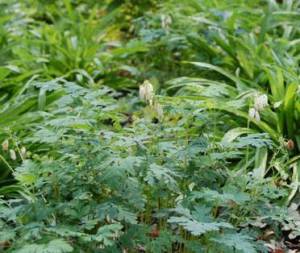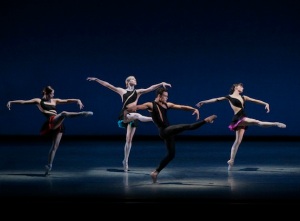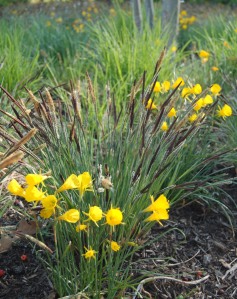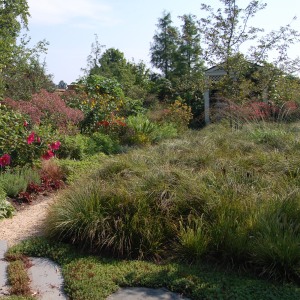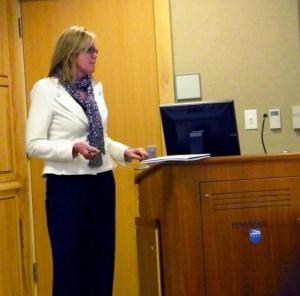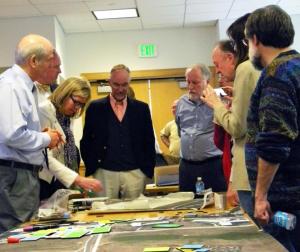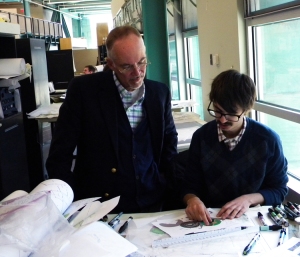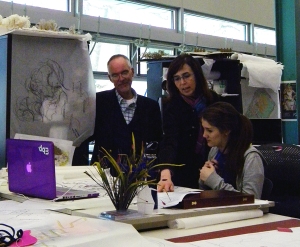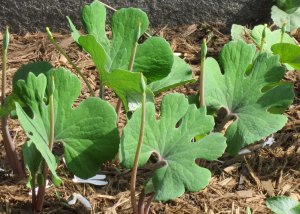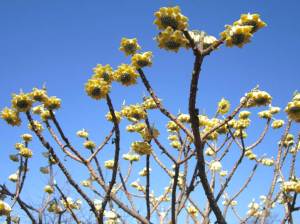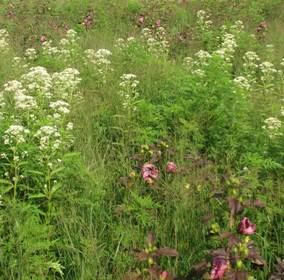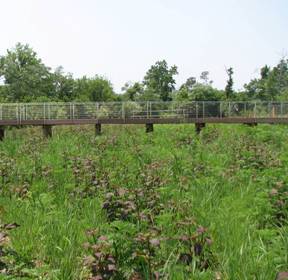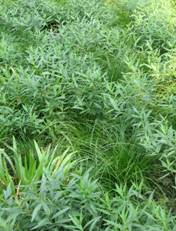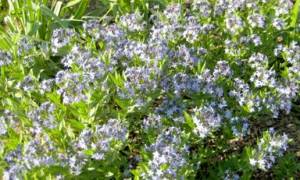OvS is thrilled to be a part of the Hines-Urban Atlantic winning team on the Walter Reed Campus redevelopment! http://ow.ly/qWCmQ
Native Range: Eastern North America
USDA Hardiness: 3-9
Height: 12″-18″
Growing Conditions: Part shade; moist, rich soils
Who ever heard of a Bleeding Heart blooming from spring into October? Dicentra eximia ‘alba’ is one of the few woodland wildflowers with such a long bloom time. We recently fell for its long-blooming delicate dangling white flowers when we planted it for a Native Garden at the New York Botanical Garden. Its lush, fern-like foliage interplants easily with native woodland sedges and ferns and makes it a wonderfully versatile plant. We have also recently paired it with Phlox subulata ‘Emerald Blue’ in the shady interior courtyard of a mixed-use building near the National Cathedral here in Washington, DC.
Posted in Plants We Love | Tagged bleeding heart, Dicentra eximia 'alba', New York Botanical Garden, oehme van sweden, OvS, Phlox subulata emeral blue, plants, washington dc, woodland sedge | 2 Comments »
We’re pleased to announce that Oehme, van Sweden has launched a new website at www.ovsla.com. The new site includes a blog, and as a result, we will no longer be posting to this WordPress blog and will be shutting it down in the next month or two. In the meantime, we encourage those who have subscribed to the blog by email to subscribe to the new blog on our website. You can do this, and read our latest blog post on Eric Groft’s talk at the Parrish Art Museum’s Landscape Pleasures event, by clicking here: http://ovsla.com/east-hampton-garden-designed-by-ovs-featured-in-parrish-art-museum-tour/. The “subscribe by email” form is located in the right sidebar.
Thank you!
Posted in Uncategorized | Leave a Comment »
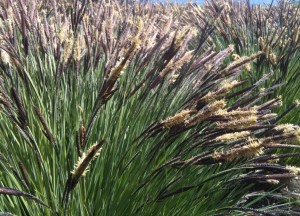
Carex elata in bloom this week in an OvS-designed estate in coastal Maine (photograph courtesy Rebecca Hoffman)
While gathered around the lunch table with co-workers today, the conversation turned, as it so often does, to plants. Today’s conversation included a lament that straight species are frequently ignored by the nursery trade in favor of more showy cultivars. Setting aside discussions of wildlife value and attractiveness to pollinators, today’s discussion was about aesthetics. “Sometimes you just need the basics,” one co-worker announced.
Carex elata is an example of just such a plant. Not to be outshown by its more widely cultivated chartreuse form, ‘Bowles Golden’, the straight species of Carex elata has found a welcome home in many OvS gardens over the years. Eric Groft and Wolfgang Oehme first happened upon the straight species decades ago at Holgar Winenga’s Garden Treasure Nursery. I vividly remember the fury of Wolfgang Oehme when a truckload including thousands of cheerily glowing ‘Bowles Golden’ arrived at a prominent federal project we were working on, instead of the specified straight species. “They look sick,” snapped Wolfgang as he ordered the plants returned. No intense yellow sedges here!
The straight species features graceful, slender, emerald-green blades. Clusters of deep brown seed capsules shoot like fireworks off the stems in mid-April. When planted in mass, Carex elata forms a dense waving sea of green by early summer. The versatile plant performs well in sun or shade, moist or dry conditions. “It’s a miracle plant!” declares OvS principal Eric Groft. Carex elata demonstrates just how beautiful and dynamic the basics can be.
Native Range: Northern and eastern Europe
USDA Hardiness: Zones 5-9
Height: 18-30”
Growing Conditions: Full sun to part shade; normal to moderately moist soils
Posted in Plants We Love | Tagged Carex elata, Eric Groft, oehme van sweden, OvS, Wolfgang Oehme | Leave a Comment »
On April 12, Eric Groft and Stacilyn Feldman joined Graham Gund, Laura Cabo and Eric Svahn of Gund Partnership for a design charette at The Pennsylvania State University. The focus of the charette was to develop a distinct entry sequence for the forthcoming phase of the University Arboretum, and existing Dickinson School of Law, as well as to site the forthcoming structures at the Arboretum, which will include a Planetarium, Education Center and Conservatory.
Nearly twenty members of the Penn State faculty, facilities management and campus design staff attended the meeting, and contributed to the design process.
Laura Cabo directed the afternoon’s discussion and presented several program options and entrance sequences.
Everyone attending actively participated in the siting of the project components and worked together meet the program needs.
OvS is delighted to be part of this project team and looks forward to the coming months of collaboration.
During our visit to Penn State, Eliza Pennypacker, professor of Landscape Architecture at The Stuckeman School of Architecture and Landscape Architecture, invited OvS Principal Eric Groft to visit the second-year design studios on Friday, April 13th. The students’ work for the Spring semester focused on complete site design, from site analysis to siting structures, organizing site circulation, and responding to existing environmental constraints and opportunities.
Eric spent a morning in the Stuckeman Family Building studios, discussing each student’s project with them, reviewing their concepts, and discussing appropriate plants and species for the intended experience.
It was a wonderful morning for both the students and Eric – sharing open dialogue about site design and the importance of great plants in the landscape. Thank you to Professor Pennypacker for the invitation!
Posted in Projects | Tagged Ben Sereda, Dickinson School of Law, Eliza Pennypacker, Emma Pritchett, Eric Groft, Eric Svahn, Graham Gund, Gund Partnership, landscape architecture, Laura Cabo, oehme van sweden, Penn State, Stacilyn Feldman, The Stuckeman School of Architecture and Landscape Architecture | Leave a Comment »
A walk through an eastern woodland in early spring is a treasure hunt for me. Only in this short window of time, before deciduous trees leaf out and while the sun still reaches the forest floor, does one have the opportunity to discover the fleeting blooms of our native spring ephemerals. This weekend, I spied some of the earliest of these, a happy colony of Bloodroot, its blossoms grouped in a gleaming white bouquet.
Bloodroot’s flower buds emerge in early spring wrapped tightly in a leaf that shares their same stem and that may help to trap warmth. The showy clear white blossoms with yellow stamens open in the sun and close at night. Bloodroot’s large leaves fully unfurl after the flowers fade. The leaves are strongly textural with deep clefts, and they in turn disappear in mid-summer when bright sunlight no longer reaches the forest floor. The metaphorical common name derives from the reddish sap exuded by the roots and stems of the plant when cut.
Last spring, OvS planted Bloodroot in several of our projects, tucking the low plants close to woodland paths amongst a richly textured groundplane of ferns and sedges like Dryopteris marginalis and Carex plantaginea that fill in as Bloodroot goes dormant. This spring, I am thrilled to watch as these delicate woodland beauties have their day in the sun.
Native Range: Eastern North America
USDA Hardiness: zones 3-8
Height: 6”-9”
Growing Conditions: Moderate to full shade; moist, well-drained soils
Posted in Plants We Love | Tagged Bloodroot, Carex plantaginea, Dryopteris marginalis, Marisa Scalera, oehme van sweden, OvS, Sanguinaria canadensis, woodland | 2 Comments »
USDA Hardiness: Zones 7-9
Height: To 7’
Growing Conditions: Light to moderate shade; deep, moist, high organic matter soils
Though this has been a particularly mild winter in Washington DC, I still find myself watching intently for signs of spring. This week, the Paperbush outside my front door has rewarded me by unfurling its unusual spherical yellow flowers. The dangling blossoms hang like large pendants from the bare stems. Welcome spring!
Paperbush’s silvery leaves emerge after it is done blooming and are reminiscent of Frangipanis. DC is near the northern edge of Paperbush’s hardiness range, and through the spring, summer, and fall it looks like its tropical cousins. Its graceful, vaselike form, smooth reddish bark, and prominent buds that form in late summer keep gardeners enticed through the winter. At OvS, we use it as a stand-alone specimen shrub in spots where it will be sure to be appreciated in late winter (near a front door or sunny terrace, or prominently visible outside an important window). Its sweet fragrance fills the air and gives all who pass by a breath of spring.
Posted in Plants We Love | Tagged Edgeworthia papyrifera, oehme van sweden, OvS, Paperbush | Leave a Comment »
Native Range: Eastern North America
USDA Hardiness: 5-9
Height: 12″-24″
Growing Conditions: Part shade; moist soils
Though best known for its dense clouds of vivid blue flowers in the early spring, this woodland native has proved a beautiful plant throughout the growing season in several of Oehme, van Sweden’s recent projects. Its blue-tinged, finely textured foliage and compact habit make it an excellent companion for woodland sedges and ferns. It also glows an eye-catching golden gold in the autumn landscape.
We planted it this spring with Carex appalachicain the new Native Garden at the New York Botanical Garden and are already impressed by its large blue-green sweeps through the dry woodland.
Posted in Plants We Love | Tagged Amsonia tabernaemontana 'Blue Ice', Eastern Bluestar, horticulture, New Native Garden, New York Botanical Garden, oehme van sweden, OvS, plants | Leave a Comment »
